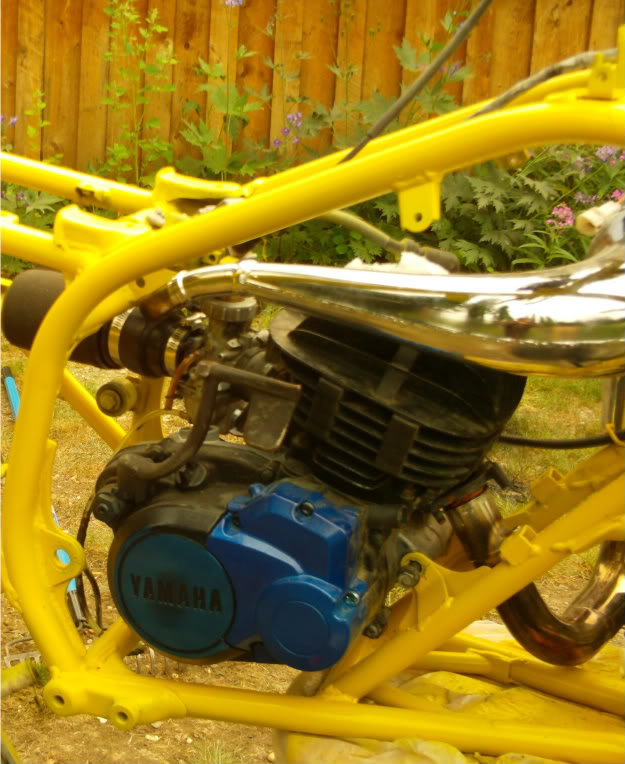Custom Blaster intake for 28mm and 30mm carbs
- Thread starter Knowpig
- Start date
You are using an out of date browser. It may not display this or other websites correctly.
You should upgrade or use an alternative browser.
You should upgrade or use an alternative browser.
This may be a newbie question, but i guess you guys aren't running in water and dust much with an open element?
Seems to me that it would work great until you hit the first puddle and suck in some water or ride in dusty conditions.
I learned that off roading in my Bronco, many years ago- better power even sounded meaner but that 2HP boost wasn't worth a damn when the filter got wet and dirty. I guess that puddle really was deeper that I expected like 5 feet deeper!!
Anyhow JMO-Bob
Seems to me that it would work great until you hit the first puddle and suck in some water or ride in dusty conditions.
I learned that off roading in my Bronco, many years ago- better power even sounded meaner but that 2HP boost wasn't worth a damn when the filter got wet and dirty. I guess that puddle really was deeper that I expected like 5 feet deeper!!
Anyhow JMO-Bob
Nice!! It turned out great.
Right he basically made a really big balancer tube. And btw a clamp on it soo much better then a box!
A balancer tube and a clamp will make more power then any box.......
Think of it this way, when air enters into a filter clamp on filter its coming from all dierections then right into the carb, so you get tons of air flow but its scattered. This makes jetting a pain and its will never be perfect, a balencer tube of 3-4" fixes that problem and atomizes the oxogen at the same time, meaning more power and easier jetting.
Heres my cheapo balencer tube

I wanted to add from a physics stand point one cannot atomize which is all ready atomized. Right theory wrong linguistics. Turbulent airflow channeling would be correct. Velocity stacks are more than what alot of you guys here think and are a tuning aid. Dont believe me pick up a sidedraft weber book once. Longer tubes or stacks with a tapered entry point are gonna give you more low end grunt. Short stub stacks are gonna give top end power. In fact what alot of you should be doing is getting weber/delleroto/sk/mikuni stacks and slipping them in and then clamping around those. Chokes could also tune velocity and trq range. Not talking choke choke but in a side draft there is a insert inside the throat that acts as a choke to channel less or more in the throat. This has a modulation ring effect on the air flow and thus effects venturi patterns.
Balancer tube is not correct either as these are used to sync multiple carbs together to get rid of individual runner pulsations due to valve over lap.
Just remember carbs are a metered fuel leak. Vacuum is needed to pull fuel from the bowel into the main circuit and then emulsifies. More area in front of the carb is gonna make a denser more compact area to draw from Ie: more vacuum at low speeds. At high speeds though this will hamper flow. Thus the smaller the stack the more top end. Longer the stack equals more low end vacuum to get things moving. You put a 40mm carb on a cyl dump the throttle nothing happens at low rpm no velocity to draw fuel out same effect on stacks. Tune accordingly.
Sorry for bringing up the dead again but i believe correct science should be stated when threads like this are being discussed. It helps nobody when things are left open or badly theorized.
Sorry for bringing up the dead again but i believe correct science should be stated when threads like this are being discussed. It helps nobody when things are left open or badly theorized.
I agree with dude, Better air velocity helps with fuel emulsion at lower rpms. Other wise you get poor throttle response or tunability at lower rpms. That is the reason Blasties have the smaller carbs than other motors that are smaller displacement. By doing what pig did would compensate having a larger carb and give a better bottom response to throttle input without losing to much air velocity.
Think of blowing across a the top of a straw in a liquid, the more you blow air across it the more fluid the straw draws up. air velocity!!
Think of blowing across a the top of a straw in a liquid, the more you blow air across it the more fluid the straw draws up. air velocity!!
Similar threads
- Replies
- 0
- Views
- 576
- Replies
- 3
- Views
- 888
- Replies
- 1
- Views
- 419
- Replies
- 5
- Views
- 946
